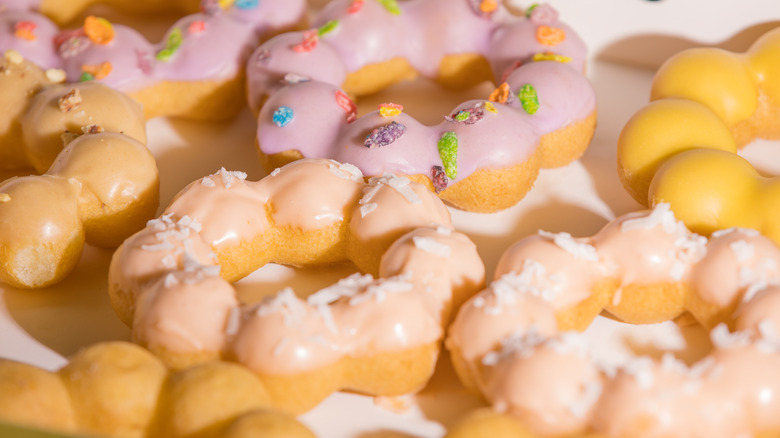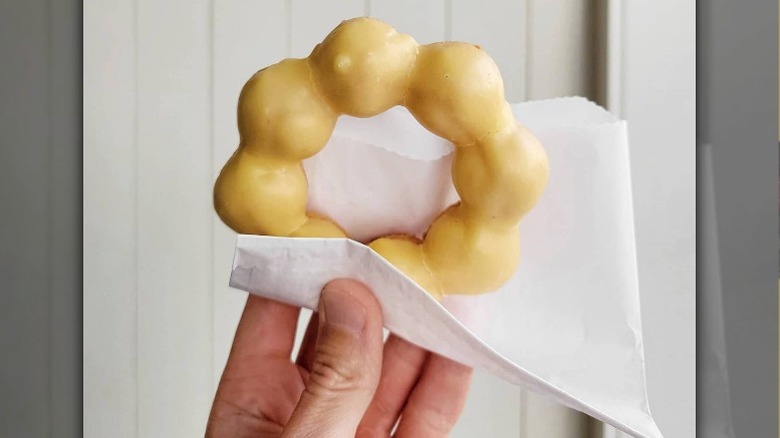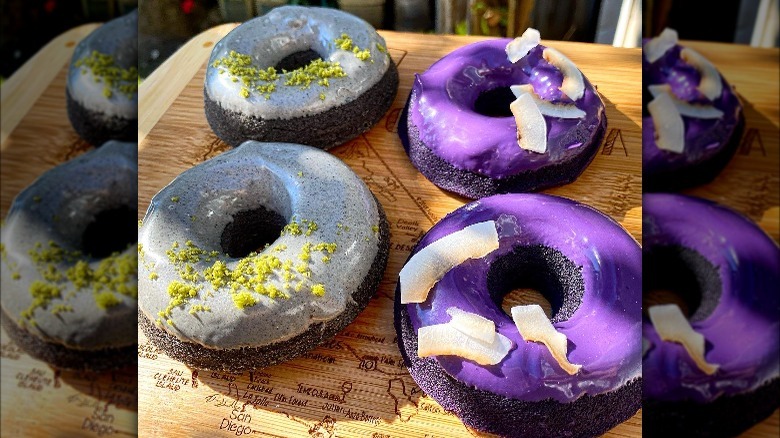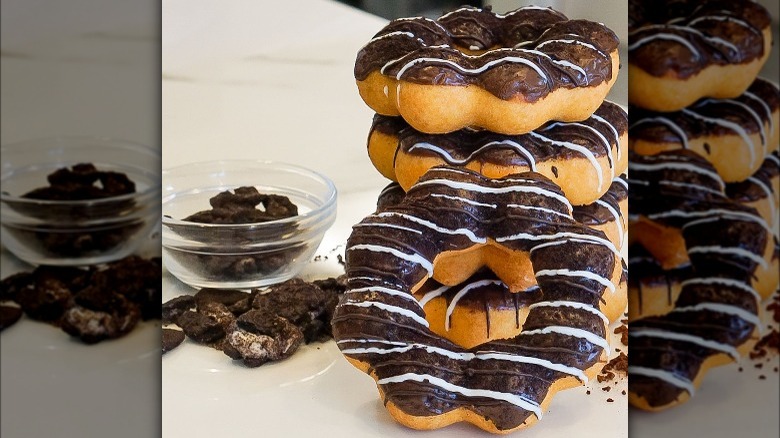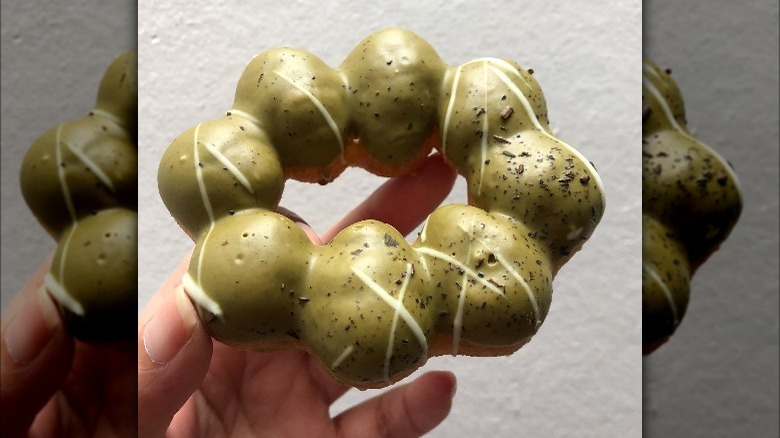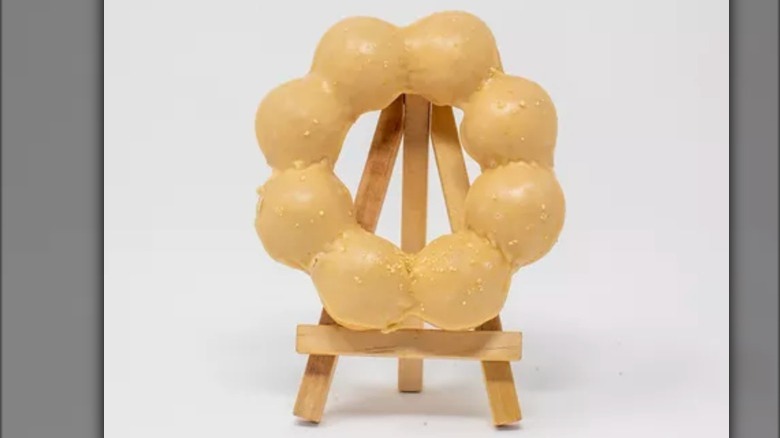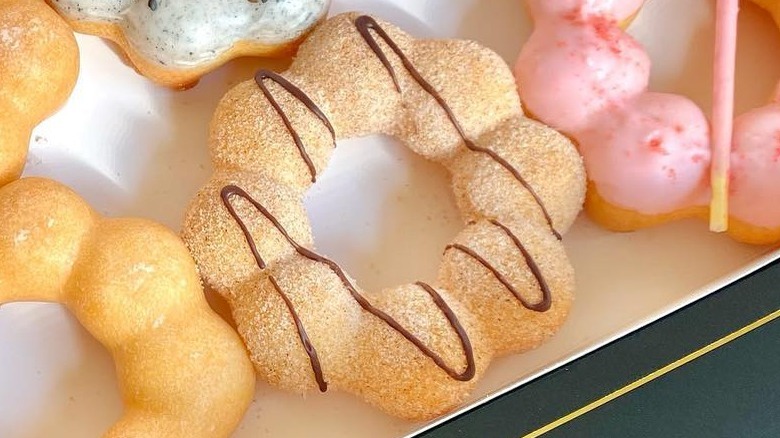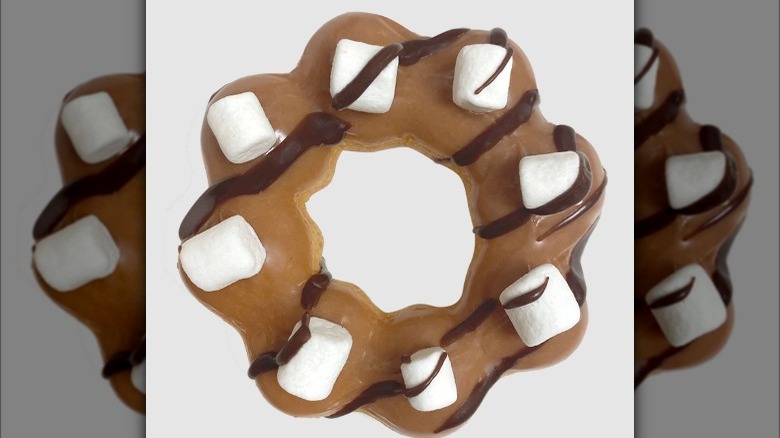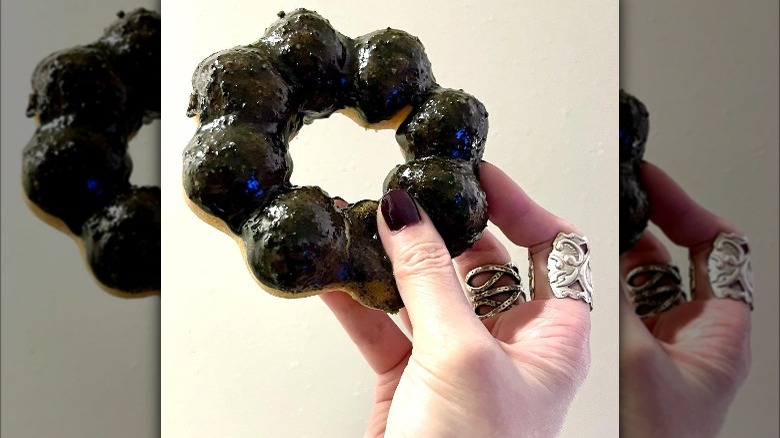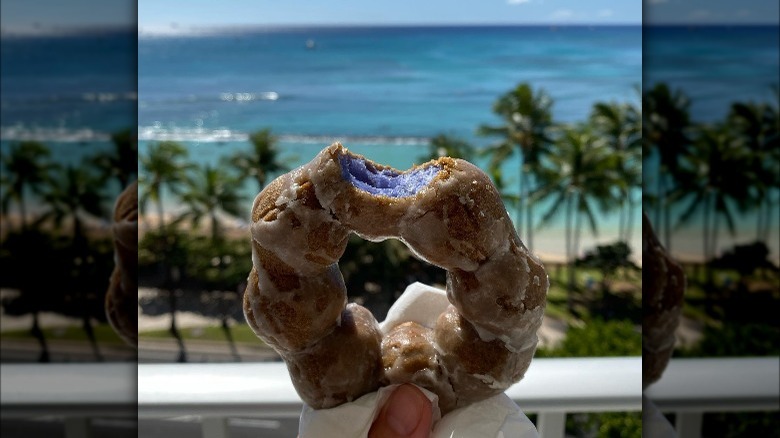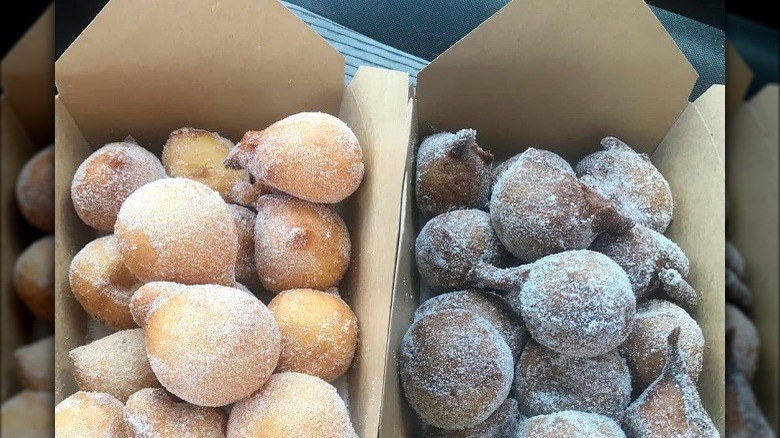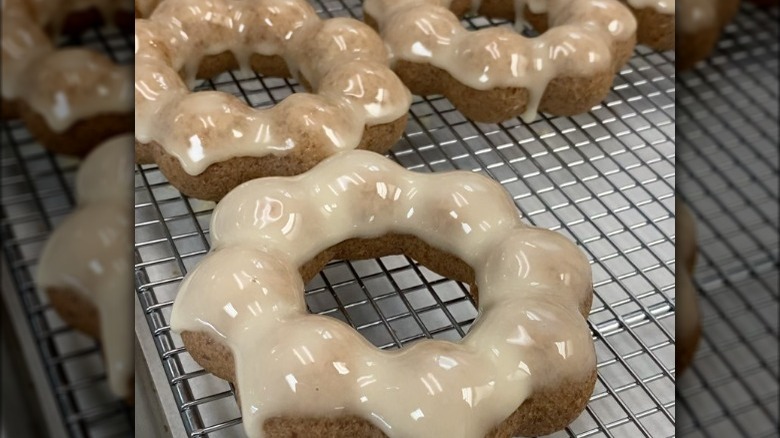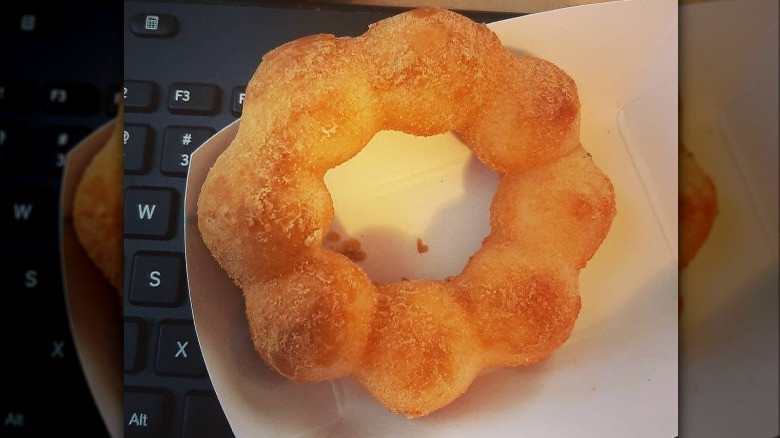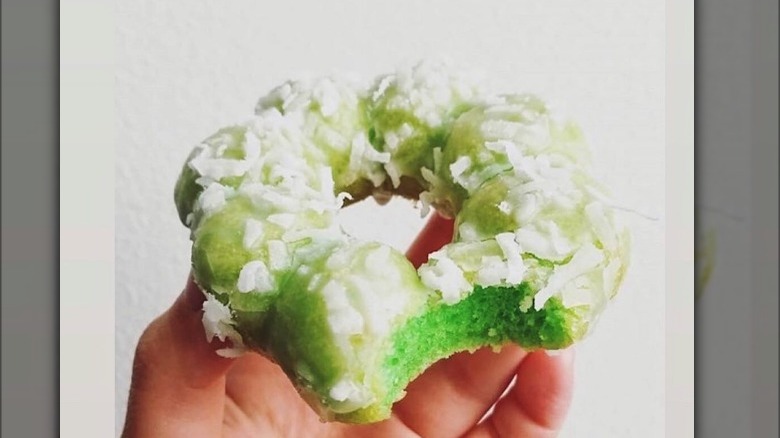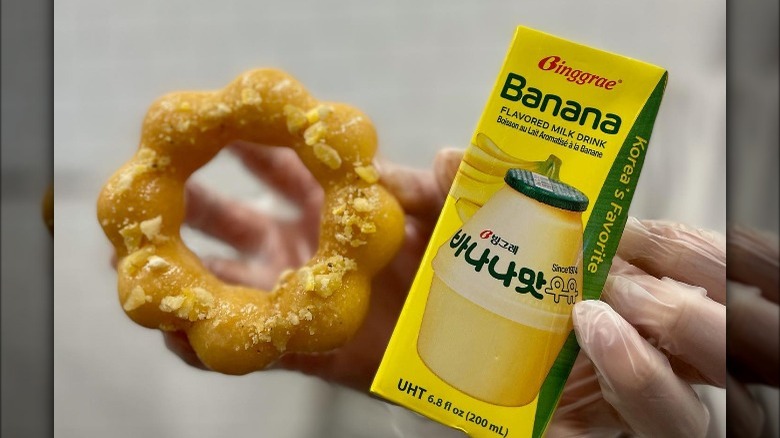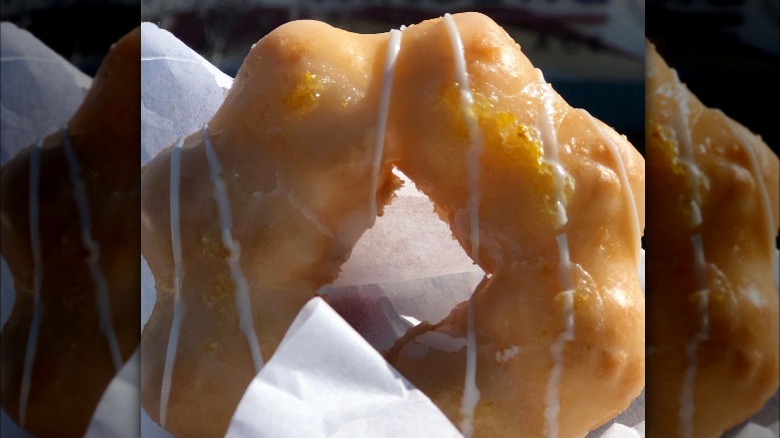15 Flavors Of Mochi Doughnuts
If you are not yet familiar with the mochi doughnut, you may want to remedy that. These adorable, flower-shaped treats have been popping up just about everywhere (not unlike daisies), and we could not be more thrilled about it. As the name suggests, a mochi doughnut is a doughnut made out of mochi. Whether it be Japanese rice flour or tapioca flour, the doughnuts boast a chewy texture that melts in your mouth. What's more, they are also a lot lighter than a traditional cake doughnut.
Per FoodBeast, this lovely baked good's story began in the early '90s in Hawaii with the invention of mochi donut holes. In 2003, the circle of connecting donut orbs — aka the pon de ring — was unveiled by Mister Donut in Japan. Since then, the confection has only continued to evolve. Nowadays, customers can enjoy mochi doughnuts in an array of glazes, colors, and toppings. And, of course, flavors. Wow, are there so many fun and fantastic flavors to be had. If you are about to go pick up a dozen mochi doughnuts and are overwhelmed by the abundance of awesome options, we understand completely. But fear not, for we have scanned menus far and wide to pick 15 mochi doughnut varieties that will not disappoint.
Lilikoi
Ah, the lilikoi, also known as passion fruit. What a treat, indeed. For those who have not had the chance to try this delicacy, it really is best to get acquainted. Passion fruit has a smooth ovular exterior, and a geode-esque interior. Once cut open, the uniform skin gives way to clusters of relatively large seeds covered by a florally fragrant, bright translucent orange, sweet, and tangy pulp. There is simply nothing else like it.
Per Hawai'i Magazine, lilikoi is native to South America and was first introduced to Hawaii in the late 1800s. It did not take long for the fruit to become a star of the archipelago's produce scene. Fast-forward some years, and the lilikoi mochi doughnut was born. Modo (short for "mochi doughnut") is one of many mochi doughnut shops offering a bite of an extremely Hawaiian dessert. Their approach is simple, as it doesn't take much to make this dessert great: The Lilikoi (Passion Fruit) Mochi Donut is a classic mochi doughnut with a lilikoi glaze.
Ube
Ube is a purple yam that has long been cultivated in Asia and received special attention and favor in the Philippines. While it is visually similar to the perhaps less obscure taro root, ube is a good bit sweeter and can be found more often than not in desserts. Its flavor is quite complex and has been described somewhere along the lines of pistachio and vanilla, according to Mic. Not for nothing, ube is a deeper purple than taro and produces exceptional confections. Suffice to say, there's a reason for ube's popularity.
Ube tends to be a top choice for mochi doughnut makers. The sweetness of the ube not only pairs well with the more down to earth mochi doughnut body, but adds an eye-catching splash of color. Dough-Wei-Mei mixes things up a bit with their Hawaii Baked Ube Coconut Mochi Donut by returning to the "traditional" donut "O" shape. It also features an ube glaze that's topped with shredded coconut brings everything back 'round perfectly. It's not every day that a doughnut is so intentionally harmonious. For at-home bakers, it could be high-time to take matters, and batter, into your own hands. DIY chefs on Reddit used the Trader Joe's Ube Waffle and Pancake Mix to make their own doughnut. (Though do note, that without mochi flour, it's technically not a mochi doughnut and won't have the same chew.)
Kona Mud Pie
Hula pie might not rank among the most famous pies in the United States, but those who do know it keep it both on their minds and mouths. Part of the appeal is the sweet, simple, and undeniably Hawaiian elements of this dish. Hula pie is always served as an ice cream dessert; one could argue the macadamia nut ice cream is maybe the most important ingredient in the recipe. But, admittedly, any pie would be lacking without the chocolate cookie pie crust, hot fudge, whipped cream, and of course, chopped mac nuts. It's certainly a dessert for the hungry.
One could say Fill Bakeshop's Kona Mud Pie mochi doughnut is more or less a handheld version of the treat. There are few twists to their recipe beyond the change in form, a smattering of Oreo cookie shells mimic the original's crust. A Kona coffee glaze only enhances this delectable treat. It's not exactly tooth-achingly sweet, but that's the point. A white chocolate and dark chocolate drizzle adds a sweet finish to the complex yet whimsical doughnut.
Matcha
Matcha is a Japanese green tea that has an incredibly vibrant hue that makes it an instant visual hit. What's more, its mellow earthy flavor is subdued yet satisfying, and it has many reported healthy qualities. While it may feel like a stretch to say a matcha mochi doughnut would do wonders for your health, it is in good faith that the combination simply "works" taste-wise. The mellowness of matcha pairs well with the sweetness of the mochi doughnut batter and adds an extra bit of sparkle.
A testament to the growing popularity of mochi doughnuts worldwide, one Japanese-style bakery in London offers a superb Matcha Chocolate Mochi Donut. The Japanese bakery does not skimp on quality in any way but nonetheless point their focus towards what goes on top: stone-ground matcha green tea is stirred into a low-key glaze. It is then stunningly topped with sweet white chocolate and a sprinkle of bitter matcha powder is used to give the entire affair an extra pop.
Injeolmi
Injeolmi mochi doughnuts are another dessert within a doughnut. Injeolmi is, as described by Hannaone, a Korean bread rice cake dessert that's made from pounded gelatinous bread. Delightfully chewy in texture, injeolmi is traditionally covered in powdered azuki beans, otherwise known as red beans. While some may second-guess adding beans to a sweet treat, azuki beans have long held a place in South East Asian desserts, per Delighted Cooking. This is most likely due to the fact that they add an aromatic, sweet, and nutty to every dish that they join. While normally red beans add, well, a clearly red element to any dish, in their dried form, they are a shockingly light brown.
Virginia-based chain Donutchew has conjured up an injeolmi mochi donut that is a rich, caramel color. If someone handed it to you without telling you the flavor, you might assume it was a peanut butter doughnut. And while that would be a good guess, you would surely realize after a bite or two that you were on a totally different legume-esque adventure.
Churros
A churro mochi doughnut is not your classic cinnamon and sugar doughnut. (That being said, we will never say no to a classic cinnamon and sugar doughnut.) Rather, it is a slightly reimagined version of the stick-shaped snack that is not only beloved but has been around for hundreds of years. Per the BBC, there is some dispute regarding its origins, but it is believed the fried dough dessert got its start in Spain, Portugal, or China. At some point, the treat landed in the Americas. Nowadays, you are likely to find cinnamon-covered churro sticks floating around festivals, theme parks, cafeterias, and sporting events.
Understandably, Mochio Chewy Donut stays close to the source material with their Tiger Churro mochi doughnut. Not unlike an actual churro, this particular mochi doughnut has a good dusting of cinnamon and sugar. To nail the landing, a fitting drizzle of dark chocolate not only alludes to traditional churro dipping sauce, but gives the tiger its stripes. To quote a certain famous cartoon tiger, these look grrrrrreat.
Mexican hot chocolate
Not unlike its flavor, the history of Mexican hot chocolate is rich. Way back when the Aztec Empire and the Maya resided in what was then known as Mesoamerica, drinking chocolate derived from cacao and spiced with chili powder was held in high regard. As anthropologist Joel Palka explained to Smithsonian Magazine, "When they had to communicate with their gods related to nature, rain, and the fertility of the earth, I'm sure they were pulling [cacao] out and drinking." Eventually, the naturally bitter flavor of the beverage was softened with sugar and cinnamon, and it remains a favorite drinkable treat to this day.
Which brings us to Mochio's Mexican Hot Chocolate mochi doughnut. This particular doughnut is topped with a Mexican hot chocolate glaze that promises all the nuance of a cup of this spiced drink, and pairs it fittingly with some mini marshmallows and a chocolate glaze. Perfect for those summer days when the heat is unwelcome but the cravings still call for a cuppa. On second thought, it is perfect for any day, no matter the season.
Black sesame
Black sesame is another flavor that might not make you think "dessert" right away. But, like a few other surprising flavors on the list, black sesame has long been utilized in desserts, especially in Asian cooking. As Brooklyn-based baker Tatiana Bautista asserts, black sesame is her go-to ingredient for baked goods. She praises black sesame for its nutty yet slightly bitter powerhouse of a flavor, noting that they also add an extra element of texture to otherwise soft foods. Though do be warned, with these seeds a little bit goes a long way. Even baking black sesame into batter will influence its taste and overall aroma.
Pandō of British Columbia offers up an aesthetically pleasing Black Sesame Mochidō. Their doughnut is served with a black sesame infused glaze that is sure to tame the otherwise strong flavor and distributes it evenly across the pastry. A sprinkling of black sesame seeds not only add extra aroma and flavor, but also a delightful crunch to the chewy doughnut.
Poi
Poi is a traditional Polynesian food made by pounding specific roots and fruits to a pulp. Per Britannica, Hawaiian poi is usually made out of taro root that has been turned into a saucy paste. It makes for a great side dish, a la rice or mashed potatoes. It also makes for a great mochi doughnut flavor.
As Honolulu Magazine reported at the time, the famed Liliha Bakery in Honolulu debuted a poi mochi doughnut in 2016. Now, this was not the first poi mochi doughnut in Hawaii; as the Star Advertiser notes, Charmaine Ocasek of Uncle Lani's Cafe created pochi mochi donut holes in 1992. However, it looks like Liliha Bakery's poi mochi doughnut was the first poi mochi doughnut in Hawaii to take on the pon de ring shape made popular in Japan.
On first glance, you might think it is an unassuming glazed doughnut; it looks a bit like an old-fashioned doughnut. However, once you get beyond the exterior, you will find a pale purple interior that is a magnificent blend of chewiness, flavor, and color. Trends come and go, but do poi mochi doughnuts hold up? Sure seems like it. As one Trip Advisor user wrote in 2021, "Those poi mochi donuts are so good that you can't stop eating. We were totally hooked." Consider us reeled in.
Malasada
Malasadas are another Hawaiian dessert, and one could argue that they are a cousin to the mochi doughnut. Malasadas are deep-fried, bite-sized doughnuts that are generously dusted with sugar. As Hawai'i Magazine notes, they are Portuguese in origin but have long since been a part of Hawaiian cuisine. Some malasadas are filled with custard, cream, fruit filling, and so on, but the traditional Portuguese version is free of filling. Hey, we will take them either way.
The malasada mochi doughnut, which Honolulu's Hau'oli Pastry calls the Mochisada, looks as if a malasada masqueraded as an extra-large chunk of mochi doughnut; if you took eight of the Mochisadas and put them in a circle. you would have a giant pon de ring. They keep the crunchy sugar powder of the malasada, but have an extremely airy and chewy texture that is characteristic of the mochi doughnut. As one Yelp reviewer notes, "First time trying the original mochisadas, will not be the last time. Amazingly flavorful, soft, sugary, just ono!!! You won't regret having one, or 5! So good!!" In lieu of glaze, the bakery offers a Chantilly dipping sauce.
Hokkaido milk tea
Hokkaido milk tea is a creamy sweet tea with a black tea base. While some might associate Hokkaido with the pumpkin, the name of this tea is all about the milk. Hokkaido milk comes from the Japanese island of Hokkaido, and it's pretty famous — and for good reason. As Sticky Mango Rice explains, "Hokkaido milk is known across Japan for its excellent quality and delicious flavour, often considered the country's best milk." This product is utilized in a number of things, such as cheeses, beer, ramen, and, of course, tea. As Artful Tea suggests, combine this milk with black tea and sweetener, and boom, you've got your Hokkaido milk tea.
Which brings us to the Hokkaido milk tea mochi doughnut. Mochio Chewy Donut uses a milk tea icing frosting in a pale orange that the site describes as creamy and rich. A sugar drizzle seals the deal and completes all the structural elements of a Hokkaido milk tea with all the chewiness of a mochi doughnut.
Kinako
A flour derived from up soybeans that boasts a nutty taste, kinako is found in a number of Japanese dishes. Yes, like injeolmi, kinako has a peanut-esque taste. However, unlike the Korean rice cake, kinako is not a standalone item. As Bokku notes, it has long been favored as a topping for desserts and snacks, such as mochi bites. Or, you know, a mochi doughnut.
Given that kinako pairs nicely with sweet treats, it really should come as no surprise that kinako mochi doughnuts are floating around. Take the Kinako mochi doughnut offered at San Francisco's Mochill. The establishment's mochi doughnut is coated in kinako and sugar, letting the same winning combo of mochi and kinako take new form and direction. And when Seattle-based bakery Raised Doughnuts and Cakes sold their own version in 2020, they upped the ante and threw in a frosting element. "Tastes a little nutty like a light peanut butter and is a must try!" they wrote on Instagram. Sure sounds like it.
Pandan
Pandan palms grow throughout Southeast Asia where their leaves are often harvested and used in a variety of ways, as per Specialty Produce. You can use the leaves to wrap meats and rice, create various drinks, bake a sponge cake, fry them up — the list goes on and on. Pandan leaves have good reason to be as popular across the board as they are, as they pack a flavor that is fresh and sweet. As Healthline explains, "Its taste is described as a grassy vanilla with a hint of coconut." Oh, and as WebMD notes, it happens to be packed with vitamins and nutrients. This plant offers a lot, does a lot, and tastes good. Talk about a triple threat tree.
MoDo, a doughnut shop located in Hawaii and California, offers up a Shamrock-green Pandan Mochi Donut. So, what might this eye-catching pastry taste like, you wonder? As described on the site, "Aromatic and balanced. Tastes like coconut pudding (and green is a cool color)!" Green is a cool color, indeed.
Banana milk
Banana milk doesn't necessarily have to be bananas and milk; it can also be a milk alternative made from bananas and water. Bananas make for an especially creamy and subtly sweet dessert, with the right ratio of water to banana, banana milk makes for a filling snack. Ever since it was introduced by milk and ice cream manufacturer Binggrae in the 1970s, banana milk has had a major footing in South Korea. Per BuzzFeed, the drink was rolled out as part of a government initiative to encourage youngsters to drink milk. And all these years later, it's still a very big deal: As Statista reported in June 2021, Binggrae's Banana Flavoured Milk remains far and away the most popular flavored milk in South Korea.
So, let's get to the banana milk mochi doughnut. Fill Bakeshop, which is located in California's Orange County region, created a banana milk glaze that not only makes for a sweet topping, but a translucent yet sunny yellow. The overall effect is that the mochi doughnut bears resemblance to a big yellow flower — a perfect aesthetic fitting the treat's sweet disposition.
Yuzu
Finally, another sun-hued concoction: yuzu flavored mochi doughnut. While they are perhaps not as bright as their banana milk counterparts, they have a much sharper, more citrusy flavor. The yuzu is as bright as a lemon, wrinkly as an orange, and around the size of a tangerine. It sounds like a riddle, but there's thankfully nothing to solve. Grown in Southeast Asia, this fruit can be found in Japanese and Korean cuisine. It is incredibly fragrant and extremely tart, it can not be eaten on its own, and can only be consumed as a zest or diluted juice. For those that prefer kick, this may be the perfect match.
Yuzu mochi doughnuts are not subtle and can even make these chewy delights refreshing. Mochido rang in the Year of the Tiger with a festive Yuzu Tiger mochi doughnut that is fittingly bedecked with semi-sweet chocolate tiger stripes. The zing of the yuzu and the sweet bitterness of the chocolate marry well and make for a visually bold dessert that roars with all the might of a tiger on to the taste buds. There's no better way to start the year, day, evening — you name it. For every occasion there's a treat, and for every flavor there's a mochi doughnut.
